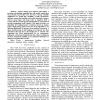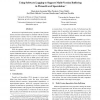174 search results - page 23 / 35 » Exceptionally Safe Futures |
IROS
2008
IEEE
14 years 2 months ago
2008
IEEE
— Robots acting in populated environments must be capable of safe but also time efficient navigation. Trying to completely avoid regions resulting from worst case predictions of...
IROS
2006
IEEE
14 years 1 months ago
2006
IEEE
— This paper describes a unique approach of applying a pattern classification technique to robot path planning. A collision-free path connecting a start and a goal point provide...
ICRA
2005
IEEE
14 years 1 months ago
2005
IEEE
– Future robotic space missions will employ a precision soft-landing capability that will enable exploration of previously inaccessible sites that have strong scientific signific...
IEEEPACT
2003
IEEE
14 years 29 days ago
2003
IEEE
In Thread-Level Speculation (TLS), speculative tasks generate memory state that cannot simply be combined with the rest of the system because it is unsafe. One way to deal with th...
ISSRE
2002
IEEE
14 years 18 days ago
2002
IEEE
Software Fault Tree Analysis (SFTA) provides a structured way to reason about the safety or reliability of a software system. As such, SFTA is widely used in missioncritical appli...


